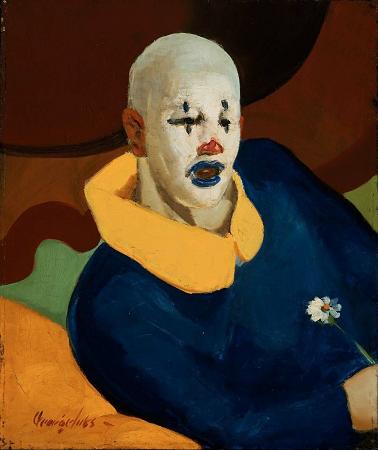George Luks (1867 - 1933). George Benjamin Luks was an American realist artist, painter, comics artist and illustrator. His vigorously painted genre paintings of urban subjects are examples of the Ashcan School of American art. Luks was born in Williamsport, Pennsylvania, to Central European immigrants. His father was a physician/apothecary and his mother was an amateur painter and musician. The Luks family eventually moved to Pottsville, in southern Pennsylvania, near the coal fields. In this setting, he learned at a young age about poverty and compassion as he observed his parents helping the coal miners' families. Luks began his working life in vaudeville. He and his younger brother played the Pennsylvania and New Jersey vaudeville circuit in the early 1880s while still in their teens. He left performing when he decided to pursue a career as an artist. Luks knew from a young age that he wanted to be an artist and studied briefly at the Pennsylvania Academy of the Fine Arts before he traveled to Europe, where he attended several art schools and studied the Old Masters. Manet's energy and technique also appealed to Luks. Later he went to Dusseldorf, where he lived with a distant relative, allegedly a retired lion-tamer, and took classes at the Dusseldorf School of Art. He eventually abandoned Dusseldorf for the more stimulating spheres of London and Paris. In 1893, he returned to Philadelphia, where he eventually found work as an illustrator for the Philadelphia Press. Luks's experience as a Press artist-reporter proved seminal to his career, not so much for the work he accomplished as for the lifelong friends he acquired. Working at that newspaper, he met John Sloan, William Glackens, and Everett Shinn. These men would gather for weekly meetings, ribaldly social as well as intellectual, at the studio of Robert Henri, a talented painter several years their senior. Henri encouraged his younger friends to read Whitman, Emerson, Zola, and Ibsen as well as William Morris Hunt's Talks on Art and George Moore's Modern Painting. Chafing under the limitations of the Genteel Tradition, he wanted them to consider the need for a new style of painting that would speak more to their own time and experience. Henri was a persuasive advocate for the vigorous depiction of ordinary life; he believed American painters needed to shun genteel subjects and academic polish and to learn to paint more rapidly. In Luks, he had a ready listener but also a man who was never going to be comfortable in the role of acolyte. In 1896, Luks moved to New York City and began work as an artist for Joseph Pulitzer's New York World, where one of his assignments was to draw the popular Hogan's Alley comic-strip series. Luks began drawing the Yellow Kid after its creator, Richard F. Outcault, departed the World for W. R. Hearst's New York Journal. During his time as an illustrator there, he lived with William Glackens. Along with Everett Shinn and Robert Henri, Glackens encouraged Luks to spend more time on his serious painting. What ensued were several productive years in which Luks painted some of the most vigorous examples of what would be called Ashcan art. The rejection of many of their paintings, including works by Luks, from the exhibitions of the powerful, conservative National Academy of Design motivated Henri's followers to form their own short-lived independent exhibiting group. Consisting of Robert Henri, George Luks, William Glackens, John Sloan, Everett Shinn, Arthur B. Davies, Ernest Lawson, and Maurice Prendergast, the group exhibited as The Eight in January 1908. Their exhibition at the Macbeth Galleries in New York was a significant event in the promotion of twentieth-century American art. Although the styles of The Eight differed greatly, what unified the group was their advocacy of exhibition opportunities free from the jury system as well as their belief in content and painting techniques that were not necessarily sanctioned by the Academy. The traveling exhibition organized by John Sloan that followed the New York show brought the paintings to Chicago, Indianapolis, Toledo, Cincinnati, Pittsburgh, Bridgeport, and Newark and helped to promote a national debate about the new realism that the Ashcan school represented. Luks' Feeding the Pigs and Mammy Groody were seen as examples of this new earthiness many art lovers were not ready to accept. Luks painted working-class subjects and scenes of urban life, the hallmarks of Ashcan realism, with great gusto.
more...













